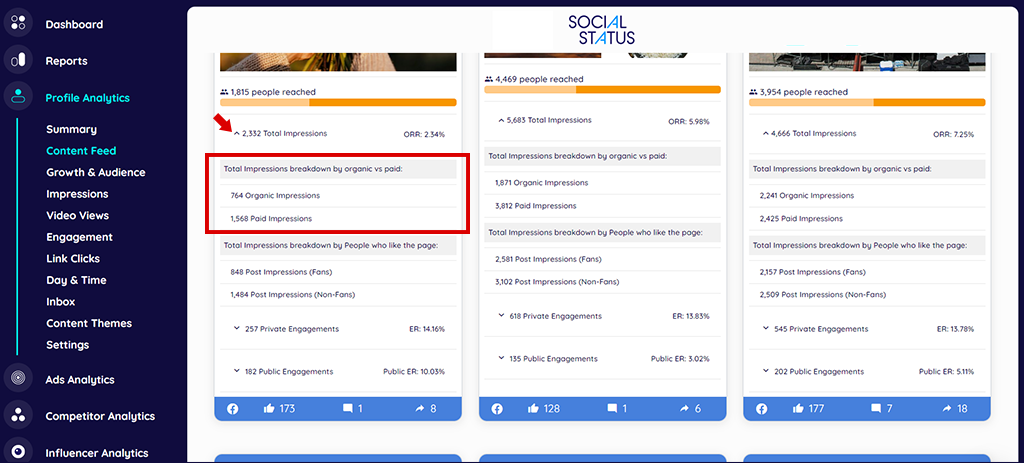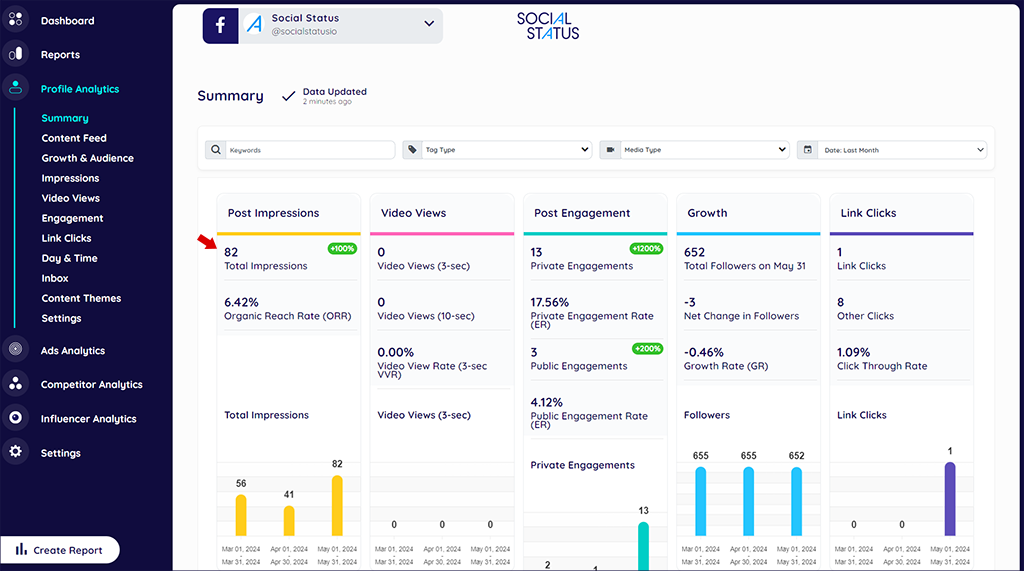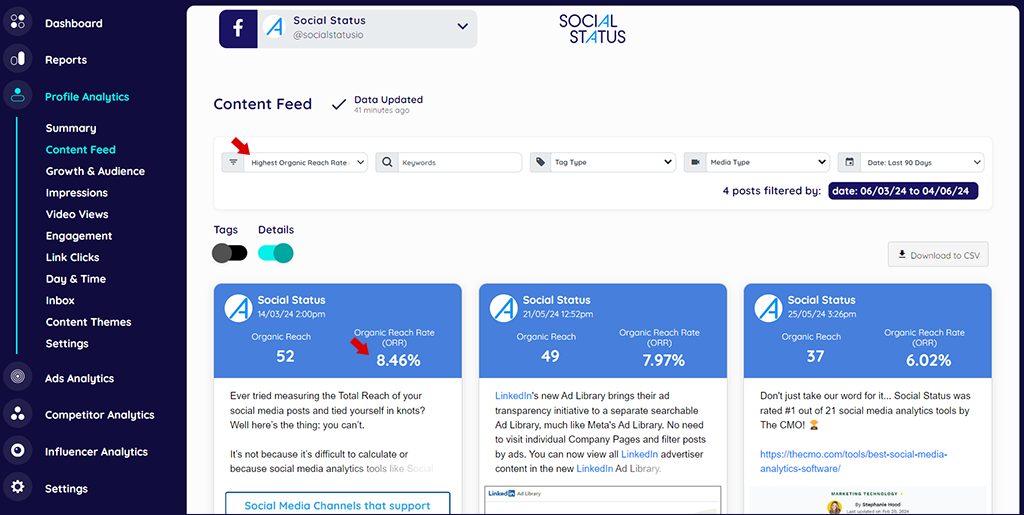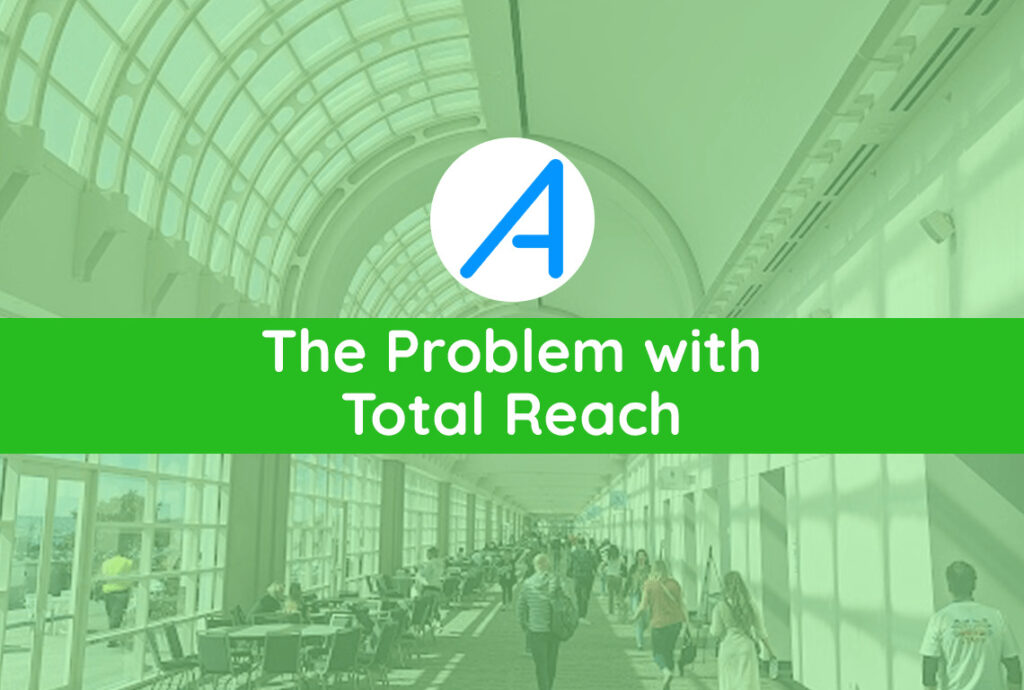Facebook Metrics
The Complete Guide for 2024

By: Tim Hill
This guide explains all the Facebook Metrics available for Facebook Pages. I’ve split this guide into two different sections. The first section covers all Facebook metrics available for Facebook Pages you manage in Meta Business Suite. These metrics can be seen in Profile Analytics.
Remember that Facebook do not provide any analytics for personal profiles, only Pages are supported. The quick distinction is that personal profiles have Friends whereas Pages do not have Friends, they can only have Followers.
The second section of the guide covers all Facebook metrics available for any Facebook pages you want to benchmark against or track in Competitor Analytics or Influencer Analytics.
Section 1: Profile Analytics
Facebook metrics for the Facebook Pages you manage in Meta Business Suite:
Facebook Impressions
Facebook Impressions is the number of times a post has been seen on Facebook. Impressions are commonly confused with Reach but are very different. Unlike Reach, Impressions are non-unique. This practically means that if 1 user sees the same post 3 times, that post will have 3 Impressions but only a Reach of 1.
Impressions are also considered a ‘top-of-funnel’ (TOFU) metric meaning, this number will be the biggest, most impressive number you can report on when it comes to your Facebook posts.
Post level Impressions
Facebook is the only social channel that provides a breakdown of Organic vs Paid Impressions on your published posts. If you’ve boosted any published posts (visible on the page) or used a published post in any ad campaign in Meta Ads Manager, you’ll see the breakdown of Organic Impressions vs Paid Impressions in Profile Analytics. You can simply click the Impressions number on any post and you’ll see the organic and paid breakdown.

Remember, if you’ve run off-page ads (also known as unpublished posts, dark posts, ghost posts, blind posts, etc) delivered straight to News Feed, these posts will not be visible in Profile Analytics. You’ll need to refer to Ads Analytics for these.
Profile Analytics also breaks down Impressions by Page Likes (Fans) vs Non-Page Likes (Non-Fans).
Profile level Impressions
Impressions exist at both the post level and at the profile level. This means all your individual Facebook posts each have Impressions. If you want to report on the Total Impressions for all your Facebook posts in a given month, you can simply sum all the Impressions together and you’ll have profile level Impressions. You’ll see your page’s Total Post Impressions on the Profile Analytics Summary too.

Facebook Reach
Facebook Reach is the number of unique people who have seen a post on Facebook. Remember, this metric is different to Impressions. Although 1 person can see a single post many times, they will only be counted as a reach of 1.
Post level Reach
Reach is available for all your Facebook posts. However, Facebook do not provide Reach at the profile level (nor do any social channel for that matter).
Warning: avoid the temptation to sum the reach of all posts and report on “Total Reach” at the profile level. Doing so would be technically incorrect. Since reach represents unique people, you would be summing multiple unique people (since 1 person is likely to have seen multiple posts) and would end up with a number somewhere between Impressions and true Reach. You might call this “non-unique reach” but you should avoid introducing exotic metrics into your report which aren’t considered standard.
Profile level Reach
Unfortunately, Facebook do not provide a Total Reach metric for your Page in a given time interval such as a month. In fact, no social channel does. I previously wrote about the problem with Total Reach. For this reason, I highly recommend you report on Impressions instead of Reach at the top of the funnel.
Facebook Organic Reach Rate
Organic Reach Rate (ORR) represents the degree to which your Page Likes (Fans) saw your published posts organically. If you rely on organic performance only and don’t have a budget for paid promotion, this is a very important metric for understanding the success of your content publishing.
If you see ORR falling month-on-month, this might indicate that you require some ad spend to promote posts so more people see them. Otherwise, what’s the point of putting all that effort into content creation?!
While some industry commentators say “organic reach is dead” and that Facebook is “pay to play” – this is objectively not the case. Some Facebook pages achieve excellent levels of organic reach (eg: 50% and higher ORR).
Post level Organic Reach Rate
At the post level, Organic Reach Rate (ORR) is calculated as Organic Reach on a post divided by Page Likes. We then multiply by 100 to get a percentage.
A really great analysis you can do on your content is to sort the Content Feed by ORR. This enables you to quickly identify which posts performed best within your selected time interval.

Profile level Organic Reach Rate
At the profile level, Organic Reach Rate is the average of all post ORRs within the selected time interval.
What’s a good Organic Reach Rate?
This is of course a subjective question. The best way to answer it is to look historically at your ORR month-on-month. Another great resource is our Facebook Organic Reach Rate Benchmark. We publish it monthly.
Facebook Video Views
Facebook Video Views are 3-seconds by default. This means if a user scrolling through News Feed sees your video or Facebook Reel and is on the screen for a minimum of 3-seconds, it will count as a “video view”.
Some would argue that this is not really a meaningful view which is why Facebook also provide other video metrics such as 10-seconds, 30-seconds and percentage-based views too.
Video Views at the post level can be summed to get total video views at the profile level.
Facebook Video View Rate
The Video View Rate (VVR) is the best metric to answer the question: “how engaging are the videos?”.
Video View Rate is calculated as Video Views divided by Post Reach. We then multiply by 100 to get a percentage. At the profile level, VVR is the average of all post VVR’s within the selected time interval.
As mentioned above, since Facebook has multiple view metrics (ie: 3-sec, 10-sec, 30-sec, etc) so too will there be multiple VVR’s. For example, 3-sec Video Views will have an accompanying 3-sec VVR metric as so on.
We publish a monthly Facebook Video View Rate Benchmark which can be a great resource for understanding the average performance of Facebook videos around the world.
Facebook Engagements
In Profile Analytics, there are 2 ways to calculate and report on Engagements and Engagement Rate.
Private Engagements
The “Private” part of Private Engagements refers to metrics that only you (and other Page Administrators) can see since you have access to the page in Meta Business Suite. Private Engagements is what we call a roll-up metric which means it’s the sum of 8 individual actions:
- Reactions (Likes, Loves, Hahas, Wows, Sads, Angrys)
- Comments
- Shares
- Video Views (3-sec)
- Clicks to Play (clicks or taps on the actual video play button)
- Photo Views (clicks or taps on an image)
- Link Clicks (clicks or taps on a URL or link card)
- Other Clicks (clicks or taps anywhere else on the post including the post text, “See More” link, profile image, page name or post date)
Private Engagements will match the Total Engagements that Meta Business Suite provides you at the post level. For that reason, it is the closest metric to Total Engagements. You can also sum all the Private Engagements of the posts within a given time interval to get the profile level Private Engagements.
Of course, “Total Engagements” is subjective and many marketers do not agree with the aggressive roll-up of 8 different actions that Facebook use. They consider this to be inflated. Furthermore, the downside of Private Engagements is that it can’t be fairly benchmarked across multiple social channels because all social channels roll-up different metrics so you’re never comparing apples with apples in a multi-channel comparison. Aside from this, Facebook have 8 aforementioned types of actions whereas Instagram has far fewer. For example, Instagram Private Engagements are based on only 3 actions (Likes, Comments and Saves). The thing to remember is not all Engagements are equal.
Public Engagements
Unlike its cousin (Private Engagements), Public Engagements refer to only the publicly visible actions on a Facebook post. These are the metrics that you can see visibly on Facebook’s News Feed for the post. Public Engagements are:
- Reactions (Likes, Loves, Hahas, Wows, Sads, Angrys)
- Comments
- Shares
Public Engagements is the perfect mid-funnel metric for benchmarking performance across multiple social channels. This is because most social channels also support 3 publicly-viewable engagement actions.
As you can see, Public Engagements is a subset of Private Engagments. There should never be any reason to sum Private Engagements and Public Engagements. You should pick the version of Engagements that works best for you (or your client).
The reason we provide both Private Engagements and Public Engagements is to let you decide how you define Engagements. If you’re undecided, I always recommend using Public Engagements for the reason above about how its the best metric for benchmarking cross-channel.
Facebook Engagement Rate
Like Facebook Engagements, there are 2 corresponding calculations for Engagement Rate (ER). One is for Private Engagements and one is for Public Engagements. Whichever you use, ER is the best metric to answer the question: “how engaging is the content?”.
Private Engagement Rate
Private Engagement Rate (ER) is calculated as Private Engagements divided by Post Reach. We then multiply by 100 to get a percentage. At the profile level, ER is the average of all post ER’s within the selected time interval.
Private ER will match the Engagement Rate reported in Meta Business Suite since it too is based on Private Engagements.
Public Engagement Rate
Public Engagement Rate (ER) is the best Engagement Rate to use when benchmarking your content across multiple channels. Public Engagement Rate is calculated as Public Engagements divided by Post Reach. We then multiply by 100 to get a percentage. At the profile level, ER is the average of all post ER’s within the selected time interval.
What’s a good Engagement Rate?
A “good” Private or Public Engagement Rate is going to be different for every marketer. This really depends on your industry, community size, demographics, content, etc. But the best way to answer this question is to look historically at your ER month-on-month. The best way to answer it is to look historically at your ORR month-on-month. Another great resource is our Facebook Engagement Rate Benchmark. We publish it monthly.
Facebook Followers
Facebook completed the migration of all ‘Classic Pages’ to New Pages Experience in March 2024. This process took over 3 years to complete. As a result, all Facebook Pages now have the Followers metric which is the new way that ‘community size’ is represented on Facebook.
Facebook Page Likes (Fans)
Way back in 2021, Facebook announced they would remove Page Likes (originally known as Fans) and yet here we are with Page Likes still being an available metric and visible on *most* Facebook Pages. The Page Like metric has polarized marketers due to its reputation as more of a ‘vanity metric’.
Although Facebook has not confirmed when they will completely remove Page Likes, I believe that Page Likes days are numbered. So if you’re still reporting on Facebook Page Likes, I suggest making the transition now to reporting on Facebook Followers instead.
Facebook Growth Rate
Growth Rate is a percentage that shows how fast a Facebook Page is growing in Followers or Page Likes (or indeed shrinking if there’s negative growth). Growth Rate is the only metric which is time-dependent. In other words, if you report monthly, you would have a monthly Growth Rate which will be a different result to say a weekly Growth Rate or quarterly Growth Rate.
Growth Rate is calculated as (number of Followers on the last day of the time interval minus number of Followers on the first day of the time interval) divided by number of Followers on the first day of the time interval. For example, if we wanted to calculate the Growth Rate for January this would be: Followers on Jan 31 minus Followers on Jan 1 divided by Followers on Jan 1. The metric is expressed as a percentage.
We publish a monthly Facebook Growth Rate Benchmark which can be a great resource for understanding the average growth performance of Facebook pages around the world.
Facebook Link Clicks
A Link Click is a click or tap on a URL in post text or on a post call-to-action button. Keep in mind that while a Link Click indicates a user has clicked a link, this does not necessarily mean they land on your website. This is why you will always see a discrepancy between Facebook Link Clicks, and your traffic stats in Google Analytics. Because it can take several seconds for your website to load inside Facebook’s mobile browser, some users get impatient and return to the News Feed before your site has a chance to load.
Facebook Click Through Rate
Click Through Rate (CTR) is the best metric to answer the question: “how effective are our link posts at driving traffic back to the website?”. Click Through Rate is calculated as Link Clicks divided by Post Reach. We then multiply by 100 to get a percentage. At the profile level, CTR is the average of all post CTR’s within the selected time interval.
Be sure to also check our our Facebook Click Through Rate Benchmark. We publish it monthly.
Section 2: Competitor Analytics and Influencer Analytics
Facebook metrics are different in Competitor Analytics and Influencer Analytics because these sections are based on public metrics only. This means you can track or benchmark any public Facebook page. And it also means you are limited to only the metrics that are publicly available.
Public Engagements
Public Engagements are the actions on any given Facebook post that are visible publicly. These are:
- Reactions (Likes, Loves, Hahas, Wows, Sads, Angrys)
- Comments
- Shares
This metric is indeed identical to the Public Engagements metric in Profile Analytics.
Public Engagement Rate
Public Engagement Rate (ER) is calculated as Public Engagements divided by Followers. The metric is expressed as a percentage and when looking at ER at the profile level, we simply average all the post ER’s during the given time interval.
Warning: the Public ER calculation is different in Profile Analytics. It is instead divided by Reach. However here in Competitor Analytics and Influencer Analytics, the Reach metric does not exist which is why we need to use Followers instead.
In Summary
This Facebook Metrics Guide will be always kept up to date with the latest metrics for Facebook Pages. Don’t forget to subscribe to our blog – Social Status Insights. For Feedly users, make sure you follow us on Feedly to always see our new articles as they’re published.

Social Media Analytics
Voted Best By You

- Quick Setup in Seconds
- Transparent Pricing
- Easy Monthly Billing, No Contracts
- Responsive Customer Support
Let’s Spill The Tea
Social Status Insights
Get our monthly social benchmarks, updates and tips via email

